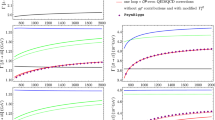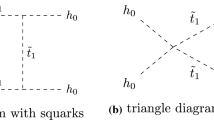Abstract
The recent discovery of a new boson at the LHC, which resembles a SM-like Higgs boson with m h =125 GeV, is starting to provide strong guidelines into SUSY model building. For instance, the identification of such a state with the lightest CP-even Higgs boson of the MSSM (h 0), requires large values of tanβ and/or heavy sfermions. One outcome of this result is the possibility to solve the SUSY flavor and CP problems by decoupling, which points towards some realization of Split-inspired SUSY scenarios, in which scalars are much heavier than gauginos and higgsinos. However, we argue here that the remaining Higgs bosons of the MSSM (H 0, A 0, H ±) do not have to be as heavy as the sfermions, and having them with masses near the EW scale does not pose any conflict with current MSSM constraints. We discuss then some SUSY scenarios with heavy sfermions, from a bottom-up approach, which contain the full Higgs sector, as well as a possible dark matter candidate, with masses near the EW scale, and identify distinctive signals from these scenarios that could be searched at the LHC.












Similar content being viewed by others
Notes
Even if Split SUSY scenarios with a Higgs sector near the EW scale may seem to be similar to the Split-inspired non-universal Higgs scenarios proposed here, in terms of the mass spectrum, it is important to emphasize a conceptual difference among them. Whereas in the former ones all the heavy states are decoupled, as Split SUSY imposes, we start from a bottom-up approach and work within a generic MSSM where only the sfermion of the first and second generations are very heavy.
Although these parameters are varied within this range, we only select points that satisfy current direct bounds on SUSY masses [58].
A study of constraints imposed by the relic abundance is needed to see whether the LSP in each of these scenarios is an acceptable DM candidate. This analysis is beyond the scope of this work, however, we point out the results from [67] where these constraints are studied in a similar region of the parameter space we scan here. It is found that it is possible to have LSP masses of \(\mathcal{O}\)(100 GeV) consistent with experiments in any of these three scenarios.
On the one hand, we select M 2=μ=1 TeV in order to generate the maximum gaugino–higgsino mixing allowed in this scenario. On the other hand, we set M 3=3 TeV because we want to maintain the spectrum below 1 TeV scale as simple as possible. We keep this criterion in the following sections for this kind of plot.
References
G. Aad et al. (ATLAS Collaboration), Phys. Lett. B 716, 1 (2012). arXiv:1207.7214 [hep-ex]
S. Chatrchyan et al. (CMS Collaboration), Phys. Lett. B 716, 30 (2012). arXiv:1207.7235 [hep-ex]
H. Flacher, M. Goebel, J. Haller, A. Hocker, K. Monig, J. Stelzer, Eur. Phys. J. C 60, 543 (2009) [Erratum: Eur. Phys. J. C 71, 1718 (2011)]. arXiv:0811.0009 [hep-ph]
J. Erler, Phys. Rev. D 81, 051301 (2010). arXiv:1002.1320 [hep-ph]
J.R. Espinosa, C. Grojean, M. Muhlleitner, M. Trott, J. High Energy Phys. 1212, 045 (2012). arXiv:1207.1717 [hep-ph]
P.P. Giardino, K. Kannike, M. Raidal, A. Strumia, J. High Energy Phys. 1206, 117 (2012). arXiv:1203.4254 [hep-ph]
J. Ellis, Int. J. Mod. Phys. A 25, 2409 (2010). arXiv:1004.0648 [hep-ph]
H.E. Haber, G.L. Kane, Phys. Rep. 117, 75 (1985)
I.J.R. Aitchison, hep-ph/0505105
D.J.H. Chung, L.L. Everett, G.L. Kane, S.F. King, J.D. Lykken, L.-T. Wang, Phys. Rep. 407, 1 (2005). hep-ph/0312378
M.S. Carena, H.E. Haber, Prog. Part. Nucl. Phys. 50, 63 (2003). hep-ph/0208209
M. Carena et al., Report of the Tevatron Higgs working group. arXiv:hep-ph/0010338
S. Chatrchyan et al. (CMS Collaboration), CMS-PAS-SUS-11-016
S. Chatrchyan et al. (CMS Collaboration), CMS-PAS-SUS-12-016
S. Chatrchyan et al. (CMS Collaboration), CMS-PAS-SUS-12-017
G. Aad et al. (ATLAS Collaboration), ATLAS-CONF-2012-103
G. Aad et al. (ATLAS Collaboration), ATLAS-CONF-2012-104
G. Aad et al. (ATLAS Collaboration), ATLAS-CONF-2012-105
G. Aad et al. (ATLAS Collaboration), ATLAS-CONF-2012-109
F. Gabbiani, E. Gabrielli, A. Masiero, L. Silvestrini, Nucl. Phys. B 477, 321 (1996). hep-ph/9604387
N. Arkani-Hamed, H. Murayama, Phys. Rev. D 56, 6733 (1997). hep-ph/9703259
J.L. Diaz-Cruz, J. Ferrandis, Phys. Rev. D 72, 035003 (2005). hep-ph/0504094
H. Baer, V. Barger, A. Mustafayev, Phys. Rev. D 85, 075010 (2012). arXiv:1112.3017 [hep-ph]
A. Arbey, M. Battaglia, F. Mahmoudi, Eur. Phys. J. C 72, 1906 (2012). arXiv:1112.3032 [hep-ph]
N. Arkani-Hamed, S. Dimopoulos, J. High Energy Phys. 0506, 073 (2005). hep-th/0405159
G.F. Giudice, A. Romanino, Nucl. Phys. B 699, 65 (2004) [Erratum: Nucl. Phys. B 706, 65 (2005)]. [hep-ph/0406088]
N. Arkani-Hamed, S. Dimopoulos, G.F. Giudice, A. Romanino, Nucl. Phys. B 709, 3 (2005). hep-ph/0409232
S.-h. Zhu, Phys. Lett. B 604, 207 (2004). hep-ph/0407072
W. Kilian, T. Plehn, P. Richardson, E. Schmidt, Eur. Phys. J. C 39, 229 (2005). hep-ph/0408088
J.L. Hewett, B. Lillie, M. Masip, T.G. Rizzo, J. High Energy Phys. 0409, 070 (2004). hep-ph/0408248
A. Masiero, S. Profumo, P. Ullio, Nucl. Phys. B 712, 86 (2005). hep-ph/0412058
P. Gambino, G.F. Giudice, P. Slavich, Nucl. Phys. B 726, 35 (2005). hep-ph/0506214
W. Kilian, T. Plehn, P. Richardson, E. Schmidt, eConf C 050318, 0205 (2005). hep-ph/0507137
S.K. Gupta, B. Mukhopadhyaya, S.K. Rai, Phys. Rev. D 73, 075006 (2006). hep-ph/0510306
F. Wang, W. Wang, J.M. Yang, Eur. Phys. J. C 46, 521 (2006). hep-ph/0512133
N. Kersting, Eur. Phys. J. C 63, 23 (2009). arXiv:0806.4238 [hep-ph]
J.-J. Cao, W.-Y. Wang, J.M. Yang, Phys. Lett. B 706, 72 (2011). arXiv:1108.2834 [hep-ph]
D.S.M. Alves, E. Izaguirre, J.G. Wacker, arXiv:1108.3390 [hep-ph]
G.F. Giudice, A. Strumia, Nucl. Phys. B 858, 63 (2012). arXiv:1108.6077 [hep-ph]
L.J. Hall, Y. Nomura, J. High Energy Phys. 1201, 082 (2012). arXiv:1111.4519 [hep-ph]
M. Dhuria, A. Misra, arXiv:1207.2774 [hep-ph]
A. Arvanitaki, N. Craig, S. Dimopoulos, G. Villadoro. arXiv:1210.0555 [hep-ph]
L.J. Hall, Y. Nomura, S. Shirai, J. High Energy Phys. 1301, 036 (2013). arXiv:1210.2395 [hep-ph]
J. Unwin, Phys. Rev. D 86, 095002 (2012). arXiv:1210.4936 [hep-ph]
M. Ibe, T.T. Yanagida, Phys. Lett. B 709, 374 (2012). arXiv:1112.2462 [hep-ph]
M. Ibe, S. Matsumoto, T.T. Yanagida, Phys. Rev. D 85, 095011 (2012). arXiv:1202.2253 [hep-ph]
B. Bhattacherjee, B. Feldstein, M. Ibe, S. Matsumoto, T.T. Yanagida, arXiv:1207.5453 [hep-ph]
J.L. Diaz-Cruz, D.K. Ghosh, S. Moretti, Phys. Lett. B 679, 376 (2009). arXiv:0809.5158 [hep-ph]
A. Delgado, G.F. Giudice, Phys. Lett. B 627, 155 (2005). hep-ph/0506217
M.A. Diaz, P. Fileviez Perez, C. Mora, Phys. Rev. D 79, 013005 (2009). hep-ph/0605285
M.A. Diaz, F. Garay, B. Koch, Phys. Rev. D 80, 113005 (2009). arXiv:0910.2987 [hep-ph]
M.A. Diaz, S.G. Saenz, B. Koch, Phys. Rev. D 84, 055007 (2011). arXiv:1106.0308 [hep-ph]
A. Djouadi, M.M. Muhlleitner, M. Spira, Acta Phys. Pol. B 38, 635 (2007). hep-ph/0609292
A. Djouadi, J.-L. Kneur, G. Moultaka, Comput. Phys. Commun. 176, 426 (2007). hep-ph/0211331
M. Muhlleitner, A. Djouadi, Y. Mambrini, Comput. Phys. Commun. 168, 46 (2005). hep-ph/0311167
A. Djouadi, J. Kalinowski, M. Spira, Comput. Phys. Commun. 108, 56 (1998). hep-ph/9704448
B.C. Allanach, Comput. Phys. Commun. 143, 305 (2002). hep-ph/0104145
J. Beringer et al. (Particle Data Group Collaboration), Phys. Rev. D 86, 010001 (2012)
A. Ibarra, Phys. Lett. B 620, 164 (2005). hep-ph/0503160
N. Bernal, A. Djouadi, P. Slavich, J. High Energy Phys. 0707, 016 (2007). arXiv:0705.1496 [hep-ph]
G. Aad et al. (ATLAS Collaboration), ATLAS-CONF-2012-127
S. Chatrchyan et al. (CMS Collaboration), CMS-PAS-HIG-12-045
S. Heinemeyer, W. Hollik, G. Weiglein, Comput. Phys. Commun. 124, 76 (2000). hep-ph/9812320
S. Heinemeyer, W. Hollik, G. Weiglein, Eur. Phys. J. C 9, 343 (1999). hep-ph/9812472
G. Degrassi, S. Heinemeyer, W. Hollik, P. Slavich, G. Weiglein, Eur. Phys. J. C 28, 133 (2003). hep-ph/0212020
M. Frank, T. Hahn, S. Heinemeyer, W. Hollik, H. Rzehak, G. Weiglein, J. High Energy Phys. 0702, 047 (2007). hep-ph/0611326
D. Hooper, C. Kelso, Phys. Rev. D 85, 094014 (2012). arXiv:1107.3858 [hep-ph]
A. Djouadi, Y. Mambrini, M. Muhlleitner, Eur. Phys. J. C 20, 563 (2001). hep-ph/0104115
N. Craig, M. McCullough, J. Thaler, J. High Energy Phys. 1206, 046 (2012). arXiv:1203.1622 [hep-ph]
C. Balazs, J.L. Diaz-Cruz, H.J. He, T.M.P. Tait, C.P. Yuan, Phys. Rev. D 59, 055016 (1999). hep-ph/9807349
J.L. Diaz-Cruz, H.-J. He, T.M.P. Tait, C.P. Yuan, Phys. Rev. Lett. 80, 4641 (1998). hep-ph/9802294
M. Carena, S. Gori, A. Juste, A. Menon, C.E.M. Wagner, L.-T. Wang, J. High Energy Phys. 1207, 091 (2012). arXiv:1203.1041 [hep-ph]
Acknowledgements
The authors are indebted to Ben Allanach, Sven Heinemeyer and Margarete Muhlleitner for valuable information about SOFTSUSY, FeynHiggs and SUSY-HIT codes, respectively. E.A. and A.S. thank Ken Kiers for fruitful discussions and a careful reading of the manuscript. E.A. is financially supported by a MICINN postdoctoral fellowship (Spain), under grant No. FI-2010-0041, and thanks IFLP-CONICET for hospitality and support. J.L. Diaz-Cruz acknowledges support from CONACYT-SNI (Mexico). This work has been partially supported by ANPCyT (Argentina) under grant no. PICT-PRH 2009-0054 and by CONICET (Argentina) PIP-2011 (E.A., A.S.).
Author information
Authors and Affiliations
Corresponding author
Rights and permissions
About this article
Cite this article
Arganda, E., Lorenzo Diaz-Cruz, J. & Szynkman, A. Decays of H 0/A 0 in supersymmetric scenarios with heavy sfermions. Eur. Phys. J. C 73, 2384 (2013). https://doi.org/10.1140/epjc/s10052-013-2384-z
Received:
Revised:
Published:
DOI: https://doi.org/10.1140/epjc/s10052-013-2384-z




